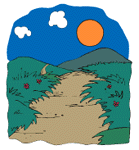
- Landscapes
Menu
- The
"A's"
- Seeking
Help from Technology
- Adapting to
Change
- Changing
the Landscape
- Return
to Eduscapes
|
|
- Adapting
to Change
-
- As you explore the new landscapes of
teaching and learning with technology,
consider ways that you can adapt to the
changing environment. Ask yourself. What
resources meet the needs of your students?
What fits your teaching style and the
learning styles of your students?
-
- This section will examine five ways
that you can begin adapting to the
changing learning environment
including:
-
- Learning Environments
- Outcomes-Based
- Global Understanding
- Local Action
- Virtual Classrooms
|
- Learning Environments
- For technology to become a transparent part of the
curriculum rather than an "add-on," "supplement," or
"extra," we need to make some fundamental changes in
the way technology is viewed. In many cases, we still
refer to technology as something special rather than a
tool we use all the time like a book or a pencil.
Let's stop using phrases such as "computer class,"
"doing computers," "tech time," and "tech
integration." We don't say that we're going to have
pencil time or marker activities, why do we say we're
going to have computer time or technology activities?
By focusing so much on the technology itself, we lose
site of the learning environment. Let's take the
example of a class web page. Many teachers create one
because they take a summer workshop or their principal
directs every teacher to make one. A successful web
classroom website needs a mission that goes beyond
just posting links. Explore Mrs.
Vilenski's website as an example of one that is an
integral part of a science classroom. She even has a
web
page to explain how the project was created and is
being used.
-
- Outcomes-Based
- Use technology to help students practice key
concepts. Focus on a particular standard and
brainstorm ways that technology can help students
learn. Let's say you want students to be able to
"categorize living organisms into groups based upon
molecular structure and anatomical similarities". A
teacher developed a wonderful online
activity that provides students with photos of
organisms that can be copied and pasted into
Inspiration software. Students can then use the
software to organize the organisms.
-
- Global Understanding
- As you explore good uses of technology in the
learning environment, think globally including new
topics, new perspectives, new partners, new
activities, and new thinking. As I explored a student
project on the topic of The
War of 1812, I found it interesting that many
perspectives were represented. This is a time in
history that is often overlooked by schools in the
United States and I wondered about the developers.
They were students from Canada, the Netherlands, and
the United States. A great way to start thinking more
globally is to look at the standards of other nations.
Check out the Ontario
Canada Social Studies requirement.
-
- Local Action
- In 1968, I remember writing a report on water
pollution. I remember reading books in the library and
examining graphic pictures of dead fish in the rivers
next to heavy industry. I wrote the paper, but never
did anything about the problem. Today, the landscape
of learning is changing. Students are becoming more
involved with "real-world' problems. They seek out
practical projects. For example, the project called
YouthCan
gets students involved with addressing real-world
pollution problems.
-
- Virtual Classrooms
- You can change your landscape without ever leaving
your classroom by taking your students on virtual
field trips. The JASON
project may be the most famous and long running
project. Throughout the year they take children on
real-world adventures from the Hawaiian Volcanoes to
the icy Arctic. Students ask questions and examine
real-world data and problems.
-
-
-
Landscapes Menu
- The
"A's"
- Seeking Help from
Technology
- Adapting to Change
- Changing the Landscape
- Return to
Eduscapes
Created by Annette
Lamb, 02/01.
|